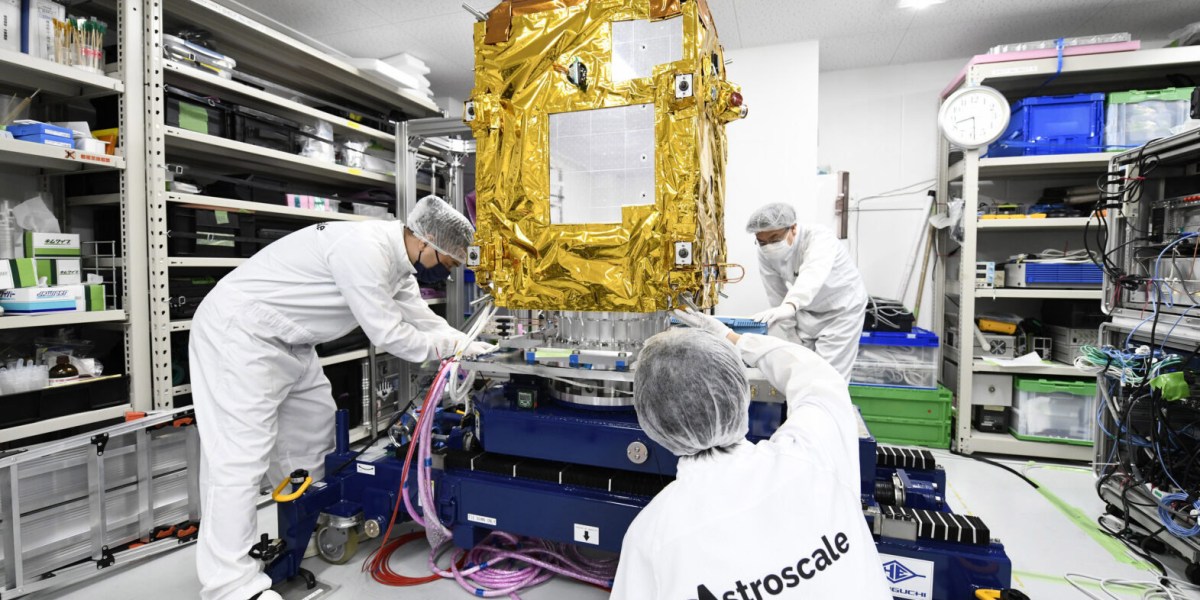The first-ever mission to pull a dead rocket out of space has just begun
More than 9,000 metric tons of human-made metal and machinery are orbiting Earth, including satellites, shrapnel, and the International Space Station. But a significant bulk of that mass comes from one source: the nearly a thousand dead rockets that have been discarded in space since the space age began.
Now, for the first time, a mission has begun to remove one of those dead rockets. Funded by the Japanese space agency JAXA, a spacecraft from the Japanese company Astroscale was launched on Sunday, February 18, by the New Zealand firm Rocket Lab and is currently on its way to rendezvous with such a rocket in the coming weeks. It’ll inspect it and then work out how a follow-up mission might be able to pull the dead rocket back into the atmosphere. If it succeeds, it could demonstrate how we could remove large, dangerous, and uncontrolled pieces of space junk from orbit—objects that could cause a monumental disaster if they collided with satellites or spacecraft.
“It cannot be overstated how important this is,” says Michelle Hanlon, a space lawyer at the University of Mississippi. “We have these ‘debris bombs’ just sitting up there waiting to be hit.”
There are an estimated 500,000 pieces of space junk as small as a centimeter across orbiting Earth, and about 23,000 trackable objects bigger than 10 centimeters. Dead rockets make up an interesting—and dangerous—category. The 956 known rocket bodies in space account for just 4% of trackable objects but nearly a third of the total mass. The biggest empty rockets, mostly discarded by Russia in the 1980s, 1990s, and 2000s, weigh up to nine tons—as much as an elephant.
These discarded upper stages, the top section of a rocket that boosts a satellite or spacecraft into its final orbit, are left to drift around our planet once the launch is complete. They are uncontrolled, spinning haphazardly, and pose a huge risk. If any two were to collide, they would produce a deadly cloud of up to “10,000 to 20,000 fragments,” says Darren McKnight, a space debris expert at the US debris tracking firm LeoLabs.
Such an event could happen at any moment. “At some point, I’d expect there to be a collision involving them,” says Hugh Lewis, a space debris expert at the University of Southampton in the UK. “There’s so much stuff out there.” That would pose a huge problem, rendering parts of Earth’s orbit unusable or, in a worst-case scenario, leading to a runaway chain reaction of collisions known as the Kessler syndrome. That could make some orbits unusable or even make human spaceflight too risky until the debris falls back into the atmosphere after decades to centuries.
Since 2007, when the United Nations introduced a new guideline that objects should be removed from space within 25 years of their operational lifetime, fewer rockets have been abandoned in orbit. Most upper stages now retain a bit of fuel to push themselves back into the atmosphere after launch. “They now tend to reserve some propellant to help them deorbit,” says Lewis. But thousands of “legacy objects” remain from before this rule was introduced, Lewis adds.
The rocket JAXA is targeting, as part of its Commercial Removal of Debris Demonstration (CRD2) program, is the upper stage of a Japanese H-IIA rocket that launched a climate satellite in 2009. Weighing three metric tons and as big as a bus, it orbits our planet at an altitude of 600 kilometers (373 miles). If left untended it will remain in orbit for decades, says Lewis, before the atmospheric drag of our planet is able to pull it back into the atmosphere. At that point it will burn up, with any remnants most likely falling into the ocean.
ADRAS-J’s mission is to figure out how to pull it back into the atmosphere before that happens. Sidling up to the rocket, the spacecraft will use cameras and sensors to inspect it from as near as a meter away. It will study the state of the rocket, including whether it is intact or if pieces have broken off and are drifting nearby, and also look for grapple points where a future spacecraft could attach.
“Designing a servicer to go up and grapple a three-ton piece of debris comes with a lot of challenges,” says Mike Lindsay, Astroscale’s chief technology officer. “The biggest challenge is dealing with the amount of uncertainty. The object has been up there for 15 years. It’s uncontrolled. We’re not communicating with it. So we don’t know how it’s moving, how it looks, and how it’s aged.”
Particularly crucial will be to determine whether, and if so how much, the rocket is spinning. Any rotation will need to be counteracted and stabilized before the rocket can then be pushed back into the atmosphere. The famous docking scene in the movie Interstellar, says Lewis, is “a perfect demonstration.”
ADRAS-J will spend the next few weeks investigating the rocket, and the inspection is expected to conclude by April. It is the first time a piece of derelict space debris will ever have been investigated in such a manner.
Japan has yet to pick the company that will conduct the second phase of the mission and actually remove the rocket from orbit, but Lindsay says Astroscale is ready, if it wins the contract. “We’re already testing some robotic capture methodologies that are compatible with the grapple points we’re going to inspect,” he says. “So it’s really important we get imagery of those interfaces.”
That mission will need to be much more substantial than ADRAS-J, says Lewis. To halt the rotation of the rocket and push it down into the atmosphere, any removal spacecraft would need to be almost as heavy as the rocket itself. “You need something equivalent [in mass] if you’re going to grab it,” he says. “If it’s tumbling end over end, you need a really capable system to manage that angular momentum.”
This is not the only effort at space debris removal taking place. In October 2023, the US Senate passed a bill to investigate removal technologies. The UK has selected both Astroscale and a Swiss firm, ClearSpace, to design missions to remove British space junk from orbit. And in 2026, ClearSpace plans to launch a mission for the European Space Agency (ESA) to remove from orbit a small piece of a European rocket, weighing about 112 kilograms (247 pounds).
“For missions after 2030, the ESA would foresee active removal to become mandatory,” says Holger Krag, the head of ESA’s Space Debris Office in Germany—that is, if a spacecraft has failed to remove itself from orbit with its own fuel.
It’s unclear exactly what shape the market for debris removal missions will take. While Japan is targeting one of its own dead rockets in good faith, tackling the daunting number of other dead rockets and satellites would be a costly endeavor. “Who’s going to pay for that?” says Lewis. “Removing one or two isn’t going to really make a dent in the problem. We need a sustained plan of removals.”
Legal hurdles abound, too. Russia and China, which have many of the largest dead rockets in orbit, are unlikely to let other countries remove their rockets for them, says Hanlon. “Private companies are not going to get permission from China or Russia to approach something that might have technological capabilities they do not want to share with the world,” she says.
There is also, currently, “no law that says you have to get your garbage out of orbit,” says Hanlon. While the UN does have its 25-year guideline, and national regulators such as the Federal Communications Commission in the US require satellites to be removed from orbit in as little as five years, empty rockets and legacy junk pose a whole other problem. “There’s no incentive to remediate,” says Hanlon.
Another option might be to reuse and recycle debris in orbit, including some of these dead rockets. Such an idea is untested at the moment, but could become viable as our operations in Earth orbit grow in the future. “Then we’re entering a different realm where there is an incentive—there is a market,” says Hanlon.
ADRAS-J, and whatever spacecraft follows in its footsteps, will demonstrate how we can start to tackle this problem. If we don’t, space junk “is just going to grow to the extent that we will not be able to launch anything,” says Hanlon. “The only way this cycle ends is to remove debris.”




